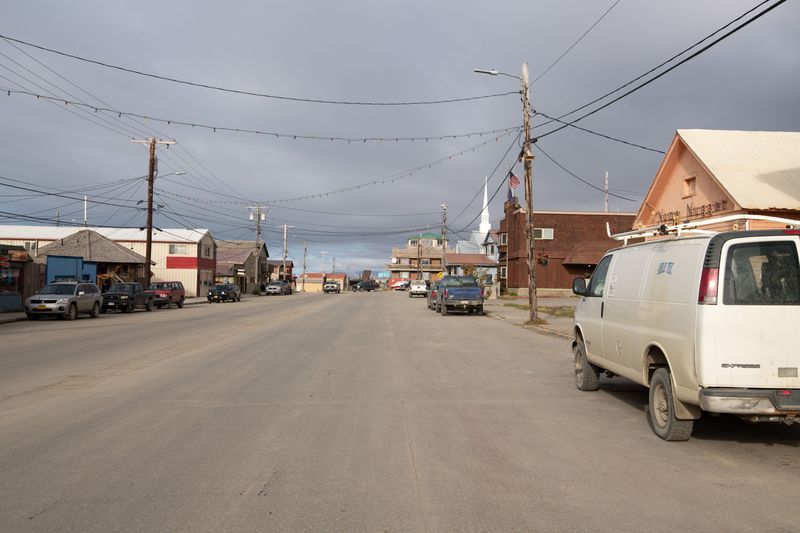
In a tiny gold mining town on the edge of Alaska, the Trump administration is poised to begin building America's first Arctic deepwater port, with significant implications for military security and tourism.
Nome, Alaska, lies on the edge of the Bering Sea, less than 200 miles from mainland Russia. Nearly 30,000 people lived there during the 1899 gold rush, but today only about 3,000 people call Nome home.
But thanks to President Donald Trump's focus on the Arctic ‒ and a changing climate that's melting the ice near the North Pole ‒ Nome could be headed for a renaissance. Federal officials are preparing to begin work on a $400 million harbor that could accommodate Coast Guard icebreakers, cargo barges and Navy warships, along with cruise ships to carry tourists north of the Arctic Circle.
Longtime resident Emily Riedel, 37, said she's hopeful the port project will boost the economy. But given its long isolation, Nome might not change as much as some think.
Riedel was a star of the long-running Discovery TV show "Bering Sea Gold," which showcased how locals mine for gold beneath the shallow waters around Nome. Riedel and her crew now have their own YouTube show with nearly 250,000 subscribers who watch miners screen for gold flakes carried down rivers from inland deposits.
"It's incredibly challenging to live there, not just because of the lack of roads, but most of the year the entire region is covered in impassable sea ice," Riedel said. "It can't really change Nome that much because Nome is only a port for three or four months of the year. The ice always wins."
What Nome is known for
Aside from the Discovery Channel show, Nome is perhaps best known as the finish line of the famed Iditarod sled dog race, which commemorates the 1,000-mile rush in 1925 to deliver diphtheria treatment despite the lack of roads.
The city also houses a small airport that funnels residents of about 50 Alaska Native villages to Anchorage for shopping and medical treatment.
Only a handful of stores and restaurants serve people in Nome, and the population drops dramatically during the long winter.
Riedel said she first arrived in Nome in 2011 thinking that dredging for alluvial gold was a "reasonable summer job." She caught gold fever and never left.
Climate change and national security
Federal officials have long seen Alaska as key to the nation's national security, and concerns have been rising as Russia and China seek greater influence in the region.
Increasingly, polar sea ice has been melting enough each summer to permit large ships to travel from Asia to Europe via the storied Northwest Passage, saving time and money for shippers who would otherwise have to use the Panama Canal.
"This is an area of the world that the Chinese Communist Party is very interested in. The Russians are very active," Adam Telle, the new director of the U.S. Army Corps of Engineers, told Congress earlier this year. "It seems to me that, if we're going to be an Arctic nation, that Alaska ought to be one of the key launching points of that force projection and power projection and economic projection."
Trump has been pushing for a stronger U.S. presence in the polar region, and the federal government recently approved plans for a major expansion of the Coast Guard's icebreaker fleet. Trump also has mused aloud about the role Greenland and Canada might play in U.S. security.
The changes a deepwater port could bring
The Army Corps of Engineers issued a $400 million contract in August to begin the first phase of the port project, which ultimately will include dredging sediment from the ocean so bigger ships can dock.
Today, the port can accommodate only ships that have a draft of less than 18 feet. That means large icebreakers, cargo ships and cruise vessels cannot dock there, so they must either anchor offshore or sail to Kodiak Island about 1,300 miles away.
About a dozen cruise ship visits were scheduled for Nome this year, and tourism experts say there's strong demand for even more cruising in Arctic waters. Most tourists to Alaska already come by ship, but the largest ships cannot yet stop in Nome because they might hit bottom near shore.
Although Alaska has long been a key location for Arctic power, it has lacked a convenient deepwater port in the north. During World War II, the military constructed its northernmost deepwater port near Anchorage in Whittier but had to blast a 12-mile-long tunnel through a mountain to link it to railroad tracks. The Corps of Engineers built the original port in 1917.
The future of Nome
Construction on the Nome project is expected to start next year and be completed in 2029, according to federal projections. The federal government has envisioned expanding the port since at least 2015 and has partly justified the need on the basis of climate change: Rising water levels are threatening coastal villages that will need better access to heavy equipment and materials to protect themselves.
Riedel, who is also a professional opera singer who has performed at New York City's Carnegie Hall, said she's buying a new boat in hopes of providing marine services to contractors working on the port expansion while also maintaining her gold mining boat The Eroica.
"Nome is such a hidden gem ‒ there's a musk ox on every corner. I'm really happy it's going to grow and expand like this," she said. "Funnily enough, it's always going to be comprised of people who are renegade and brave enough to live there, or brave enough to try find their fortune under the water or ice."
This article originally appeared on USA TODAY: Trump administration has big plans for this small Alaskan town
Reporting by Trevor Hughes, USA TODAY / USA TODAY
USA TODAY Network via Reuters Connect

 USA TODAY National
USA TODAY National
 Newsweek Top
Newsweek Top Associated Press Top News
Associated Press Top News AlterNet
AlterNet Raw Story
Raw Story Reuters US Domestic
Reuters US Domestic Associated Press US News
Associated Press US News Elle
Elle